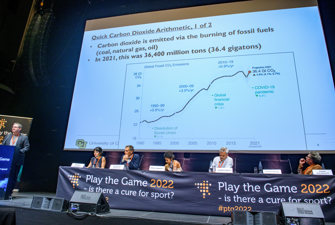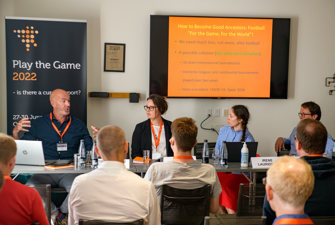A thought experiment: Estimating global sports’ total carbon emissions
It is difficult to determine exactly how much the global sports sector contributes to the world’s carbon emissions. In this article, David Goldblatt draws on case studies from international championship circuits and big profesisonal leagues to produce an estimate and assess the importance and role of sport in the world’s wider programme of climate action.
Given all the complexities and inconsistencies of emission reporting, not to mention the huge numbers of organisations that have yet to deliver a carbon audit, it is only possible to estimate the sports industry’s carbon footprint but this article makes an attempt in the form of a thought experiment.
Using case studies from the section on sport’s carbon emissions as a guide, this article also discusses what might be the total global emissions of the sports industry. It takes the international championship circuits and the big professional leagues as its starting point and then extrapolates the figures to include other leagues and sports. The estimate is then put into the context of overall CO2 emissions to ask what the real contribution of limiting sports’ carbon footprint would be.
The international championship circuits
Over a four-year cycle, the Olympics and the men’s football World Cup alone are emitting 1.5-2.5 tCO2e a year.
These events are the pinnacle of a global network of international competitions. The global federations of every one of the Olympic sports (more than thirty across the Winter and Summer Games) hold World Championships and often continental championships too on a regular basis.
What level of emissions are these events responsible for? One way of coming at this is to look at the research in Sportcal’s 2017 Global Sporting Impact report which, over the four-year cycle from 2013-2106, compiled a list of the leading 317 global sporting events.
They found that there were 54 million spectators at these events, of which the World Cup and the Winter and Summer Olympics accounted for 10 million spectators. So that’s just under a fifth of the total spectator numbers for the international sports circuit.
However, the World Cup and Olympics are probably more carbon intensive per spectator than other events as there is more international travel and more consecution associated with them. To allow for that, let’s assume that their emissions (around 2 million tCO2e) constitute a fifth to a quarter of the circuits’ output. This translates into total emissions from international sports competitions of around 10 million tCO2e annually.
The big professional leagues and tours
Let’s start with the US major leagues. Based on the estimates above of 2 million tCO2e for MLB and 0.7 for NHL, the total for MLB, NHL, National Football Legaue (NFL), National Basketball Association (NBA), and Major League Soccer (MLS) can be rounded out as 5 million tonnes.
Then add all the US minor leagues in those five sports, women’s leagues, and college sports, all of which have considerable levels of attendance. Triple-A baseball in the US, for example, has as many spectators as the EPL. Call it another million tCO2e.
Then add:
- the major global football leagues by attendance (England, Spain, Italy, Germany, France, Mexico, Japan, Brazil) totalling around 100 million spectators
- the major baseball leagues (China, Japan, Korea, Mexico, Venezuela), with an annual attendance of around 40 million
- the major attractions in cricket (the IPL in India, Australia’s Big Bash) and the international test circuit attract around 5 million spectators a year
- golf (the US, European and Asian Tours) and tennis (the ATP circuits), at around another 10 million spectators
- motor sport spectators (F1, NSCAR, Moto GP) around 7 or 8 million spectators
- cycling (above all the great European road races like the Tour de France and the Giro D’Italia which attract more than 12 million spectators each) for a total European season of more than 30 million spectators.
Adding up the American and other leagues and given all the sports and nations that are not included here, we arrive at a figure of more than 200 million spectators a year. Taking the EPL as a yardstick, approximately 10 million spectators produce 0.5 million tCO2e. Some sports may be less carbon-intensive per spectator, some more, but going with this assumption, a figure of 20 million tonnes a year from professional sport’s more than 200 million spectators does not seem outlandish. Add on the international circuits emissions and the total stands at around 30 million tCO2e.
Large as these figures may seem, they are almost certainly a considerable underestimate.
Consider this:
The size of the global sports industry has been calculated at around 500 billion US dollars a year. Global GDP is 85 trillion US dollars which means that sport makes up about 0.6 per cent of the global economy which is responsible for 50 to 60 billion tonnes of tCO2e.
Sport may be less carbon intensive than some economic sectors – like concrete production – but it is also very heavy on travel especially aviation, so its 0.6 per cent of global GDP is probably something close to generating 0.6 per cent of global emissions. Looked at this way sport would be responsible for 300–350 million tCO2e.
The role of sport is to be a catalyst and exemplar
Where, then, do sports’ plans for carbon zero fit into the world’s wider programme of climate action?
Even taking the low estimate of sport’s emissions, it is equivalent to that of small nations. The higher estimate at around 300 million tCO2e makes it equivalent to a medium-sized and higher emissions state like Poland.
No one is suggesting that national emissions of this size are not an important component of the world’s emissions.
That said, even if sport was to go comprehensively carbon zero, it will only be making a small contribution to dealing with the problem.
This, however, should not be seen as an argument for either not making these efforts, or indeed to see them as marginal. Sport’s role in this process is to be a catalyst and exemplar, to show that radical decarbonisation in all walks of life is possible, essential, and urgent. Sport is well placed to make a major cultural and political contribution.
- Sport has a global and demographic reach that no other popular cultural phenomenon can claim.
- Sports, especially professional clubs and star athletes, retain a high degree of trust and influence with the global public that few other advocates of climate action can match.
- Sport, above all team sports, remains a rare place in which the public believes in the power of collective action – both amongst athletes and in the dynamic interrelationship of crowd and athletes.
- Sport is a rare cultural space in which people experience the possibility of radical turnarounds and last-minute victories – precisely the emotional and psychic space that the climate movement requires if it is to break down the walls of cynicism that block collective climate action.
If sport is to realise the political potential of these cultural resources, it is vital that it puts its own environmental house in order by moving rapidly to a carbon-zero economy.
Table: Comparing global sport to nations by estimated carbon emissions
|
Emissions tCO2e |
Sport |
Nation |
|
1 |
English professional football |
Burundi |
|
3.6 |
Qatar 2022 World Cup |
Namibia |
|
10 |
International Circuit estimate |
Cote d'Ivoire |
|
20 |
Professional league estimate |
Bolivia |
|
30 |
Total sport, low estimate |
Cuba |
|
300 |
Total sport, high estimate |
Poland |
Missing emissions
Three other elements of the global sports industry which have, so far, not been included in sport’s carbon accounting are also worth thinking about.
Grassroots sport
Quite simply there are no estimates of how much grassroots, amateur, and recreational sport is contributing to global sport’s carbon emissions. Data on how many people are participating in sport is notoriously inaccurate, and how they are travelling and consuming is equally opaque.
FIFA’s survey came up with a figure of 275 million people playing football on a regular basis, which is about the same as the total spectator attendance at global sport. Certainly, the number of regular participants worldwide in all sports will be in the hundreds of millions, and the travel, facilities, and equipment this entails will have a very considerable carbon footprint.
This is one of the areas of the climate and sport debate where new research is most needed, and where decarbonisation plans need to be most urgently thought about.
Broadcasting
Broadcasting is integral to global sport, and it has its own carbon footprint related to moving staff and equipment around the world and using energy to run computers and cameras. This is not usually included in carbon auditing in the sector, which it should be.
In the UK, the main sports broadcasters have developed their own carbon-zero broadcasting protocols – Albert – which is a useful model for the rest of the global industry. However, no one in the broadcasting industry has as yet fully incorporated all of the carbon emissions associated with streaming and internet use, which are considerable.
The sportswear industry
The sportswear industry is tightly integrated with the global sports industry, and its sponsorship of tournaments, clubs and athletes is central to building brands and driving sales. By the same token, sports federations, clubs, and athletes draw very considerable income from their work with these global corporations.
It is obvious that an industry that turns over more than 200 billion US dollars a year, has huge global supply chains requiring vast amounts of transport, and which relies on many fossil fuel-based raw materials, is going to have a colossal carbon footprint.
Puma, the third largest corporation in the sector has reported annual carbon emissions of almost 40 million tCO2e, bigger than the lowest estimate for the whole sports industry above.
Some consultancies report that the shoe industry alone is responsible for one per cent of all global emissions and sports shoes are mainly made of petroleum-derived fabrics (polyester, thermoplastic polyurethane (TPU), polyethylene terephthalate (PET) and ethylene-vinyl acetate (EVA) ) which are the heaviest carbon emitting materials used in the fashion industry.
However, the leading manufactures – Nike and Adidas – have yet to actually publish comprehensive carbon audits that include all parts of their supply chains, and the emissions associated with post-consumption waste. While both of these companies have detailed sustainability policies and publish some data on carbon, they are simply not transparent or comprehensive.
This is the single most important absence in the debate. It would be untenable for global sport to make a huge effort to go carbon zero, without a parallel effort from the sportswear industry.
Key reading
J. Amann and M. Doidge: Climate change, catastrophe and hope in football fandom: Football as an island of hope in a warming sea of despair. In Sport and Physical Activity in Catastrophic Environments (pp. 161-174). Routledge.












